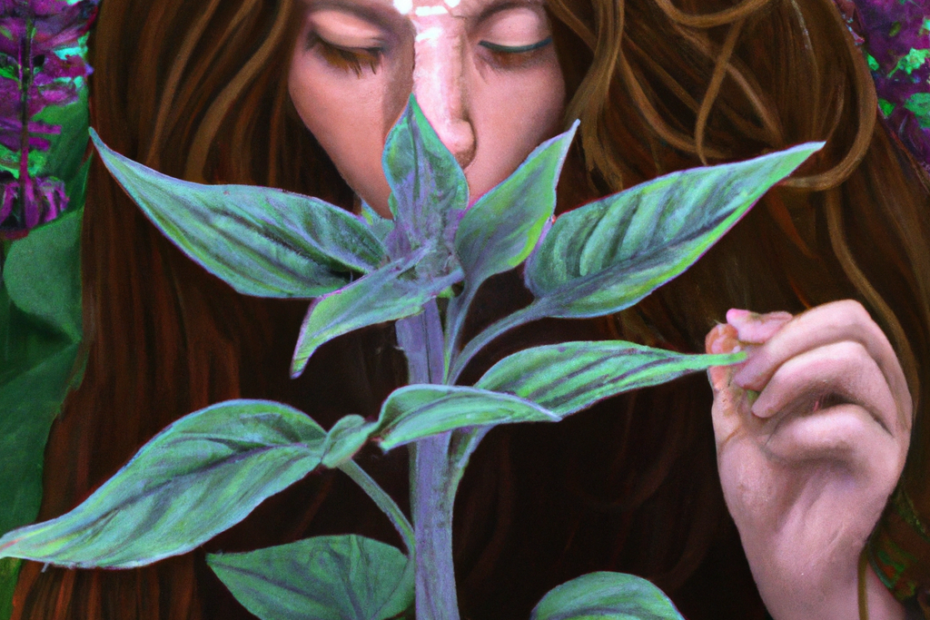Salvia divinorum, a member of the mint family, is a unique and potent psychoactive plant native to the cloud forests of Mexico. The propagation of salvia divinorum is a fascinating process that offers enthusiasts the opportunity to cultivate and expand their own supply of this mystical herb.
In this comprehensive guide, we will delve into the various techniques for propagating salvia divinorum, including growing from seeds, rooting cuttings, layering, tissue culture, and grafting. We will also explore the optimal conditions required for successful propagation, such as temperature, humidity, light, soil, and watering.
We will address common problems encountered during the propagation process, including pests and diseases, watering issues, lighting concerns, nutrient deficiencies, and root rot. Whether you are a seasoned horticulturist or a curious newcomer, this article will provide you with the essential knowledge and insights to embark on your own salvia divinorum propagation journey.
What Is Salvia Divinorum?
Salvia Divinorum is a perennial herb belonging to the mint family, commonly known for its psychoactive properties and traditional use in shamanic practices.
It is native to the cloud forests of the Sierra Mazateca in Oaxaca, Mexico and has been utilized by the Mazatec people for centuries. The plant is characterized by its large, green, and deeply veined leaves, bearing clusters of white or purple flowers. The traditional method of propagation involves using cuttings rather than seeds, as the plant has limited fertility. Cultivation techniques such as controlled temperature and humidity are essential for successful growth.
In traditional practices, Salvia Divinorum is often consumed by chewing the fresh leaves or through infusion in water to induce altered states of consciousness for spiritual insights or healing purposes.
Where Is Salvia Divinorum Found?
Salvia Divinorum is native to the cloud forests of Mexico, although it is now cultivated and studied in various botanical gardens worldwide, drawing the interest of horticulturalists and cultivar enthusiasts.
These botanical gardens aim to replicate the unique environmental conditions of the plant’s native habitat, allowing for controlled studies and propagation. This cultivation not only serves as a means for conservation but also provides an opportunity for horticulturalists to explore the potential of different cultivars, leading to the development of new varieties with diverse traits.
Through these efforts, the significance of Salvia Divinorum in horticulture continues to be realized, offering valuable insights into the plant’s characteristics and potential applications.
What Are The Different Ways To Propagate Salvia Divinorum?
There are various techniques for propagating Salvia Divinorum, including propagation from seeds, rooting cuttings, layering, tissue culture, and grafting, each offering unique advantages and challenges for successful cultivation.
- Propagation from seeds is a cost-effective option, but it requires patience as it can take longer to establish a mature plant.
- Rooting cuttings, on the other hand, allows for quicker replication of desired traits.
- Layering involves encouraging a stem to develop roots while still attached to the parent plant, promoting rapid establishment.
- Tissue culture enables mass propagation under controlled conditions, ideal for preserving specific genetic traits.
- Grafting is another method used to propagate Salvia Divinorum, allowing for the union of different varieties, offering potential benefits in terms of disease resistance and growth characteristics.
Growing From Seeds
Growing Salvia Divinorum from seeds involves specific steps such as seed germination, selection of a suitable growing medium, and the use of appropriate propagation tools for successful planting.
To start, the germination process can be initiated by placing the seeds in a moist paper towel within a sealed plastic bag, ensuring they are kept in a warm and humid environment. Once the seeds have sprouted, they can be transferred to a well-draining, rich soil mix with adequate moisture retention.
Utilizing a propagation tray or small pots, the seeds can then be carefully planted at a shallow depth, allowing them to establish and grow. Regular misting and proper lighting are essential for the initial growth stages, ensuring the young plants receive the necessary care and attention.
Rooting Cuttings
Rooting cuttings of Salvia Divinorum involves the application of rooting hormone, careful planting in appropriate pots, and strategic transplanting to ensure successful establishment and growth of new plants.
This process begins with selecting healthy, disease-free Salvia Divinorum stems and using a sharp, sterilized knife to take cuttings from the parent plant. The cuttings are then dipped in rooting hormone to encourage root formation. Once treated, they are planted in well-draining, soilless potting mix, and placed in a warm, humid environment to promote root development. After roots have developed, the new plants can be carefully transplanted into larger pots or the garden, ensuring minimal disturbance to the delicate root system.
Layering
Layering is an effective propagation method for Salvia Divinorum, involving techniques such as air layering and simple layering, which can mimic natural cloning processes to produce new plants.
By using air layering, a portion of the plant stem is induced to form roots while still attached to the parent plant, resulting in a genetic replica. Simple layering, on the other hand, involves burying a portion of the stem to promote root development. Both methods encourage the growth of new, independent plants, making them valuable for expanding a cultivated Salvia Divinorum population.
These techniques simulate natural processes of plant reproduction, allowing for the successful cloning and propagation of this unique plant species.
Tissue Culture
Tissue culture offers an advanced approach to propagating Salvia Divinorum, allowing for mass production of uniform plantlets in controlled nursery environments, ensuring genetic purity and rapid multiplication.
This method is instrumental in the propagation of Salvia Divinorum as it provides a reliable means of reproducing the plant on a large scale while maintaining the desired genetic traits. By utilizing tissue culture in nursery production, growers can significantly enhance the efficiency of cultivating this valuable herb. Tissue culture enables the preservation of Salvia Divinorum’s genetic diversity, which is essential for its sustainability in the face of environmental changes and increasing demand.
Grafting
Grafting, although less common, can be employed in propagating Salvia Divinorum, enabling the fusion of desired cultivars onto compatible rootstocks, a technique often utilized by horticulturalists to create specific plant hybrids.
This process involves carefully joining the tissues of the desired cultivar onto the rootstock, ensuring that the vascular systems align to facilitate nutrient and water uptake. By grafting, horticulturalists can combine the desirable traits of different Salvia Divinorum varieties, such as resistance to specific diseases or environmental conditions, ultimately enhancing the overall vigor and quality of the plants. As a result, grafting plays a significant role in the development and diversification of Salvia Divinorum cultivars, contributing to the advancement of horticulture in creating unique and resilient plant varieties.
What Are The Best Conditions For Propagating Salvia Divinorum?
The successful propagation of Salvia Divinorum requires careful attention to environmental conditions, including optimal soil composition, appropriate watering practices, adequate light exposure, specific temperature ranges, and suitable humidity levels.
It is crucial to ensure that the soil for Salvia Divinorum is well-draining, with a slightly acidic pH level around 6.0 to 7.0. Regular watering is essential, but it is important to avoid waterlogging the soil, as this can lead to root rot.
Providing the plant with indirect sunlight or partial shade is ideal, as too much direct sunlight can cause leaf burn. Maintaining a consistent temperature between 65-85°F (18-29°C) and a relative humidity level between 50-80% creates an optimal environment for the successful growth of Salvia Divinorum.
Temperature
Maintaining the ideal temperature for the growth and cultivation of Salvia Divinorum is essential, as it directly impacts the plant’s development, metabolic processes, and overall health.
The ideal temperature for Salvia Divinorum is around 70-85°F (21-29°C) to foster optimal growth. Deviations from this range can lead to stunted growth, reduced medicinal potency, and susceptibility to diseases and pests. Temperature control also plays a pivotal role in regulating photosynthesis, nutrient uptake, and water retention, all of which are crucial for the plant’s well-being. Therefore, maintaining a consistent and suitable temperature environment is crucial for successful cultivation of Salvia Divinorum.
Humidity
Humidity levels play a critical role in the plant care and environmental conditions required for propagating Salvia Divinorum, influencing transpiration, nutrient uptake, and overall physiological well-being.
Maintaining appropriate humidity levels is crucial for creating an optimal growing environment for Salvia Divinorum. Proper humidity ensures that the plant can effectively transpire, regulating its water loss and ensuring that it can efficiently absorb nutrients from the soil. Maintaining the right humidity levels supports the plant’s physiological processes, promoting healthy growth and development.
Without adequate humidity management, the plant may experience stress, leading to reduced vigor and potentially compromising its overall well-being.
Light
Light exposure is a vital environmental factor for Salvia Divinorum, influencing photosynthesis, photoperiodism, and overall plant development in the given environmental conditions.
It plays a crucial role in regulating the opening and closing of stomata, which affects gas exchange and water loss in the plant. The duration and intensity of light exposure can influence the production of essential plant pigments and hormones, ultimately impacting the growth, flowering, and overall physiological processes. Salvia Divinorum, like many plants, has adapted to specific light requirements for optimal growth and productivity.
Understanding the intricate relationship between light exposure and plant development is fundamental in creating suitable environments for the successful cultivation of Salvia Divinorum.
Soil
Selecting the appropriate soil and growing medium is crucial for the successful propagation of Salvia Divinorum, as it directly influences root development, nutrient uptake, and overall plant health.
The right soil composition provides a stable foundation for the plant to establish a strong root system, allowing for effective nutrient absorption and water retention. A well-draining growing medium is essential to prevent waterlogging, which can lead to root rot and hinder growth. Using a mix that offers good aeration and moisture balance will support the plant’s vigor and facilitate its adaptation to new environments during the propagation process.
Watering
Effective watering practices are essential in the environmental conditions required for successful propagation of Salvia Divinorum, influencing hydration, nutrient distribution, and overall physiological balance.
Proper watering techniques play a vital role in providing the optimal moisture levels essential for the growth of Salvia Divinorum. The right watering schedule addresses the specific needs of this plant, ensuring that it receives adequate hydration while preventing waterlogged conditions, which can lead to root rot. It facilitates the efficient distribution of nutrients, enabling the plant to thrive in its environment and maintain a healthy physiological state. By understanding the impact of watering on Salvia Divinorum, cultivators can enhance its propagation and contribute to its successful cultivation.
What Are The Common Problems In Propagating Salvia Divinorum?
The propagation of Salvia Divinorum may encounter challenges related to pests and diseases, issues with rooting hormone application, nutrient deficiencies, and the potential development of root rot, requiring careful management and preventive measures.
These challenges can make the propagation process complex, especially when pests like aphids and spider mites infest the plants, leading to stunted growth and yellowing leaves. Diseases such as powdery mildew and fungal infections can affect the plant’s overall health. Ensuring proper air circulation, maintaining optimal humidity levels, and regularly inspecting the plants can help in early detection and control of these issues.
Over application of rooting hormone can lead to toxicity, hindering root development, and careful monitoring of nutrient levels is essential to prevent deficiencies that can impact growth and vitality.
Pests and Diseases
Pests and diseases pose significant challenges in the propagation of Salvia Divinorum, requiring effective disease management strategies and pest control measures to maintain plant health and vitality.
These challenges can include a variety of pests such as aphids, whiteflies, and spider mites, which can debilitate the growth and development of Salvia Divinorum. Diseases like powdery mildew and root rot can spread rapidly, jeopardizing the overall well-being of the plant. Implementing integrated pest management techniques, such as regular monitoring, biological controls, and minimizing plant stress, is crucial in combating these issues. Proper sanitation practices and the use of disease-resistant cultivars can significantly reduce the impact of diseases on Salvia Divinorum propagation.
Over- or Under-watering
Over- or under-watering can adversely affect the successful propagation of Salvia Divinorum, leading to physiological imbalances, root issues, and compromised plant health in the given environmental conditions.
For instance, over-watering can lead to root rot and oxygen deprivation in the soil, hindering the plant’s ability to absorb nutrients effectively. Conversely, under-watering may cause wilting, leaf curling, and stunted growth, ultimately impacting the overall health and vitality of the Salvia Divinorum.
These water-related challenges highlight the significance of maintaining optimal moisture levels and environmental conditions to support the successful propagation and sustainable growth of this unique plant species.
Improper Lighting
Improper lighting conditions can pose challenges in the successful propagation of Salvia Divinorum, affecting photosynthesis, growth patterns, and overall plant development within the given environmental conditions.
This can lead to reduced chlorophyll production and hinder the plant’s ability to convert light energy into chemical energy, which is essential for its growth. Inadequate lighting can cause stunted growth, elongated stems, and leaf discoloration, influencing the overall health and vigor of the Salvia Divinorum plants.
In such conditions, the plants may struggle to complete their life cycle, impacting their reproductive potential and overall sustainability. Therefore, ensuring proper lighting is crucial for fostering optimal conditions for Salvia Divinorum propagation and maximizing its potential yield and quality.
Nutrient Deficiencies
Nutrient deficiencies can impede the successful propagation of Salvia Divinorum, necessitating focused fertilization and soil management to address specific nutrient requirements in the given environmental conditions.
This is especially crucial in environments where essential nutrients, such as nitrogen, phosphorus, and potassium, may be lacking. Without proper supplementation, the plant’s growth and overall health may suffer, affecting its ability to thrive. Understanding the specific nutrient needs of Salvia Divinorum in its natural habitat is essential for creating an optimal growth environment.
Targeted fertilization, along with thoughtful soil management, plays a critical role in providing the necessary nutrients for its healthy propagation, ensuring robust and vibrant growth.
Root Rot
The development of root rot can present a significant challenge in the propagation of Salvia Divinorum, demanding vigilant disease management and plant care practices to prevent and address this issue effectively.
This fungal disease, caused by excess moisture and poor soil drainage, can compromise the health and vitality of Salvia Divinorum plants. To mitigate root rot, it is crucial to provide well-draining soil, avoid overwatering, and ensure proper air circulation around the roots. Periodic inspection of the roots for any signs of discoloration or decay is essential for early detection and intervention. Incorporating natural fungicides or beneficial microorganisms into the soil can also aid in preventing the onset of root rot, thereby promoting the successful propagation of this valuable plant.
Frequently Asked Questions
What are some common Salvia Divinorum propagation techniques?
Some common propagation techniques for Salvia Divinorum include using stem cuttings, root cuttings, and tissue culture.
How do I take stem cuttings for propagating Salvia Divinorum?
To take stem cuttings, choose a healthy stem and make a clean cut just below a node. Remove any lower leaves and place the cutting in a container with water until roots develop.
Can I propagate Salvia Divinorum from root cuttings?
Yes, Salvia Divinorum can be propagated from root cuttings. Choose a healthy root and cut it into sections, making sure each section has at least one node. Place the cuttings in a container with water until new shoots develop.
What is tissue culture and how is it used to propagate Salvia Divinorum?
Tissue culture is a propagation technique that involves taking a small piece of tissue from a plant and growing it in a sterile environment with nutrient medium. This method is used to quickly produce a large number of plants from a single source and can be used for Salvia Divinorum.
Are there any special considerations for propagating Salvia Divinorum?
Yes, Salvia Divinorum is a sensitive plant and may require extra care when propagating. Make sure to use sterile equipment and follow proper hygiene practices to prevent contamination. Also, keep in mind that Salvia Divinorum is a perennial plant and may require specific growing conditions for successful propagation.
How long does it take for Salvia Divinorum to grow from a cutting?
The time it takes for Salvia Divinorum to grow from a cutting varies depending on the propagation method and growing conditions. Generally, it can take anywhere from a few weeks to a few months for new shoots to develop from stem or root cuttings.
John Marston, a seasoned writer since 2009, has penned hundreds of articles on Salvia Divinorum across the web. As a full-time writer at a prominent online salvia retailer, he continues to contribute valuable insights, combining expertise and passion to unravel the diverse facets of Salvia Divinorum. Beyond his writing, John serves as a budtender in the cannabis industry.




